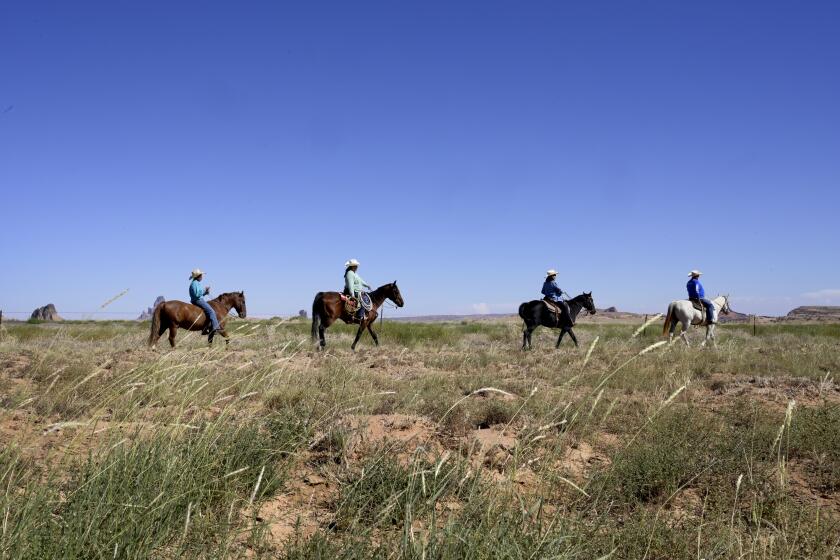Wilson Unveils Plan to Sharply Limit Welfare
Gov. Pete Wilson will seek one of the most demanding welfare overhauls in the nation this spring, starting with an unprecedented proposal to cut off aid to new recipients after just one year if they don’t find jobs, administration officials said Tuesday.
The strict limit in Wilson’s plan--outlined for the first time by administration officials prior to the governor’s annual State of the State address--cuts in half the time allowed by last year’s landmark federal welfare bill.
For current welfare recipients, officials said, the governor would allow up to two years to obtain a job.
In both cases, those who are dropped from the rolls could return in one year until they reach a lifetime limit of five years on aid.
“This is the greatest challenge facing us this year,” Wilson said Tuesday evening to the annual joint session of the Legislature. “If we fail to address this before we adjourn, we fail not just taxpayers; more importantly, we fail the people whose lives we can so dramatically change for the better--especially poor, fatherless children.”
In addition to the time limits, the governor’s proposal would also subject welfare recipients to a challenging and intrusive gantlet of requirements that are all mandatory to receive aid. And it gives counties broad discretion--and substantial responsibility--for designing the innovative programs that will be required to move recipients into the work force.
Wilson’s outline will represent the starting point for a historic debate that is expected to surround the Legislature’s effort this spring to redesign California’s social safety net.
Based on early reaction to the ideas Tuesday, state leaders will probably begin the discussion with sharply different ideas but similar expectations for a divisive and partisan battle.
Senate President Pro Tem Bill Lockyer (D-Hayward) called the governor’s plan “a menu of punishments, rather than a safety net for the least fortunate in our state.”
“The emphasis seems to be on punishing poor people instead of helping them find jobs,” he said. “The state should help--not victimize--small children.”
Lockyer’s Republican counterpart, Senate Republican leader Rob Hurtt of Garden Grove, described the ideas as “pretty tough . . . I like what I hear.”
Hurtt, who applauded the one-year time limit, said, “I think about 99% of the people of California would approve. The other 1% is in the Legislature and that’s too bad.”
Casey McKeever, directing attorney for the Western Center on Law and Poverty, called Wilson’s welfare proposal unprecedented treatment of the poor.
“To say that no matter what the circumstances of the economy, or the age of your children or the hardships or barriers that a parent has faced, income support will be eliminated after only one year is ruthlessly harsh,” McKeever said.
Wilson triggered some partisan anger over welfare with a line in his speech that was applauded by Republicans and condemned as demeaning by Democrats.
“There’s a lot more dignity in any minimum-wage job than sitting on a couch collecting welfare,” Wilson said.
The governor opened his roughly half-hour address by calling for a special session of the Legislature to address recent storms in Northern California that may have produced the state’s most costly flooding in history.
The special session would allow bills that are passed for disaster relief or repairs to take effect in 90 days. Legislative leaders, who have also recommended such a session, also suggested that the special session address plans to bolster the area’s system of river levees, many of which have failed in the last week.
Wilson made only brief reference to public safety issues, usually a staple of his State of the State speeches. Tuesday he raised the issue by highlighting a recent series in the Los Angeles Times that profiled the notorious 18th Street gang.
Wilson cited a gang member’s comment about wanting a brother as an example of the missing role models that he hopes to supply with his proposal for an expanded army of adult mentors to at-risk youths.
“We’ve got to get that kid a better big brother than that gang,” Wilson said.
This year, the governor’s focus was on solutions to social decay. Even his proposals to stimulate the economy were linked to the plans for changing welfare.
In his view, good schools are needed to build an educated work force and substantial job growth will be required to end welfare.
“California cannot afford a jobs climate that loses jobs if we are to move our people from welfare to work in the numbers and on the schedule mandated by federal welfare reform,” Wilson said in his address.
The governor issued several education proposals that he has outlined in recent weeks--primarily a plan to reduce class sizes in kindergarten through third grade, eliminate another round of university fee increases and purchase computers for all of the state’s high schools.
For the second year in a row, Wilson said California is leading the nation in job growth and in 1996 it became the first state to achieve a $1-trillion economy.
But, saying further economic stimulus is still needed to keep the state competitive, Wilson recommended a 10% tax cut for banks and corporations to be phased in over the next two years.
The proposed cut would add to a 5% reduction lawmakers also targeted for banks and corporations last year.
With his speech, Wilson dropped his two-year effort to cut individual income taxes by 15% over three years. The idea--announced just before Wilson launched his ill-fated presidential bid in 1994--was rejected twice by the Legislature.
Welfare, however, looms as the elephant at the tea party in this year’s Legislature.
Every year since taking office in 1991, Wilson has sought incremental changes to welfare. Since then, welfare checks for the average family of three in California have been cut by about $100 per month.
Since August, when President Clinton signed the landmark welfare bill that gives far more authority for public assistance to the states, Wilson has been largely silent on his vision for the upcoming overhaul.
On Tuesday, administration officials, including state Social Services Department Director Eloise Anderson, gave a briefing for reporters just prior to the governor’s address. They said more details of the governor’s welfare plan will be announced Thursday when he unveils his proposed budget for the 1997-98 fiscal year.
In all, the changes place the state in the bureaucratic role of welfare referee, with counties on the hook for doing much of the delicate and difficult maneuvering that will be required to meet federal work standards.
Anderson said the state will establish welfare eligibility standards and set grant levels and time limits. Beyond that, it will leave counties to make the most fundamental decisions about moving welfare recipients into the work force.
Wilson predicted that the state will need to generate about 1 million jobs for welfare recipients in order to meet the federal work standards. The first requirement comes this summer, when 25% of the state’s welfare caseload is required to be employed.
Officials said they are optimistic about meeting that goal because about 20% of the caseload is already employed in a manner consistent with the requirement. But they acknowledged more concern about future thresholds.
Wilson’s proposals represent a finding by the state that most welfare recipients need substantial one-on-one contact with the state to change dependency patterns that sometimes transcend generations.
Like other states, California social workers also plan to address families as a whole rather than as individuals.
For example, Wilson’s plan would create a new Minor Parent program in which home visits will be made by social workers to all welfare recipients under age 18. During the visit, social workers will assess many potential problems in the household, such as juvenile delinquency of siblings.
Welfare recipients would also face substantial intrusion in their personal lives.
Mothers would be required to establish paternity--through blood tests if necessary--for all of their children.
Also, any adults found to be abusing drugs or alcohol could not receive aid. And, assistance would be cut to families in which the children do not attend school or do not have required immunizations.
Wilson officials said they will try to protect children who might be jeopardized by the penalties. Before a family is dropped from aid, for example, officials said a home visit will establish whether any children would be jeopardized. If so, a protection program will address the need.
Times staff writers Carl Ingram, Dan Morain, Virginia Ellis and Max Vanzi contributed to this story.
* VALLEY REACTION: Speech brings both applause, scorn from local lawmakers. (San Fernando Valley Edition, B4
(BEGIN TEXT OF INFOBOX / INFOGRAPHIC)
Governor’s Welfare Plan
Major elements of Gov. Pete Wilson’s welfare reform plan, as outlined Tuesday by his administration:
WORK: Able-bodied adults in single-parent families will be required to work 32 hours per week to be eligible for assistance. In two-parent families, the primary wage earner will be required to work 35 hours per week.
CHILDREN: Families will be refused cash grants if children do not attend schools or do not obtain required immunizations.
SUBSTANCE ABUSE: Cash grants will be ended for adults who misuse drugs or alcohol.
TIME LIMITS: New welfare applicants will be required to find work within one year or lose their cash grants. Existing welfare recipients would be allowed two years to find employment before losing their assistance. In each case, for those dropped from welfare, assistance could be resumed after one year. For both, there is a lifetime limit of five years on public assistance.
SCREENING: A new screening process at welfare offices will determine ability to work and categorize applicants according to need for training or other services.
SUPPORT SERVICES: Increased funding will be made available to address barriers to employment--primarily drug treatment and child care.
PATERNITY: Cash grants will be ended for any woman who does not establish paternity for all of the children in her care.
MOTHERS: A new Minor Parent Program will establish government home visitations of families in which the mother is under 18. The home visitations will assess not only the welfare applicant, but also the problems of the household, such as a delinquent teenage brother.
COUNTIES: Counties will be provided wide flexibility. The state will establish the welfare eligibility standards, the time limits and the grant levels. Counties will be allowed to determine how they will reach work requirement goals and they will be held accountable for failures. As an incentive, counties will receive 25% of the state’s savings from moving people off welfare and into jobs.
SAFETY NET: Before a family is dropped from welfare assistance, an evaluation will be made to determine whether any children might be placed at risk. If so, the child’s needs will be addressed in a new protection program.
More to Read
Get the L.A. Times Politics newsletter
Deeply reported insights into legislation, politics and policy from Sacramento, Washington and beyond. In your inbox three times per week.
You may occasionally receive promotional content from the Los Angeles Times.










